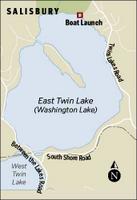
Trout Flourish From Alewives' Tale By TOMMY HINE Hartford Courant July 19 2005
SALISBURY -- Bernie Haab doesn't walk to the dock at O'Hara's Landing without scooping a few live shiners from the tank and bringing them with him. "As you walk on the dock, the fish can hear you," Haab said. "They expect to be fed. Sometimes, you'll see bass so big, they look like submarines. The bigger ones jump right out of the water when you feed 'em." Nailed to the dock where Haab drops the shiners in the water, a sign says, "No Fishing - These Are Pets." It is probably the only spot where anglers can't catch fish at East Twin Lake, renowned for its large brown trout. The state record, a 16-pound, 14-ounce brown, was caught there by Samuel Wright in 1986. Last year, a 14-pound, 6-ounce brown trout was caught at East Twin, and a 21-pounder was once found dead along the shore. The latter fish was 10 inches long when stocked in the lake two years earlier. In the '70s, Department of Environmental Protection biologists captured a 30-pound brown trout and released it.
"It's the alewives," said Haab, who has leased and run O'Hara's Landing with his son David for 28 years. "Brown trout thrive on the alewives." Seven years ago, Bernie Haab saw alewives in the lake for the first time. However the baitfish got there, it was done illegally. In no time, the alewives destroyed Connecticut's best kokanee salmon fishery. "They're both gill feeders," Haab said. "The alewives took away their feed. Salmon fishing was already declining for whatever reason, but this didn't help the situation any, that's for sure."
Rumors abound on how alewives found their way into East Twin Lake. "One person, who shall remain nameless, says the DEP put them there because the state didn't want to deal with the salmon stocking anymore," Haab said. "Other people say some fishermen came here and dropped them in. They got here some way, and it's not all bad in the overall scheme of things."
The alewives improved the brown trout fishery immeasurably. "All of a sudden alewives were everywhere," Haab said. "They reproduce very fast. On a clear, sunny day, you can see them on top of the water in huge 40-foot circles. "There are so many alewives, the water boils. The brown trout come up from beneath and feed on them."
The excellent water quality in East Twin helps holdover browns survive year to year. "It's the best lake to fish, anywhere," said Haab, who makes the half-hour trip from his home in Millerton, N.Y., six days a week. "Every day but Tuesday," said Haab, 90. "I do pretty well for myself. Retire? Why should I?" East Twin is also one of the state's prettiest, with the northwestern hills in the background framing the lake water below, even on a dark, cloudy day. "When the sun shines, the water is bright blue and the water visibility is crystal clear," Haab said. The picturesque lake is home to more than just brown trout and alewives.
Rainbow trout are included in the 16,000 catchable-sized trout stocked in East Twin every spring. Rock bass also thrive there, as do largemouth bass, chain pickerel, black crappie and yellow perch. Haab, who spends winters in Florida with his wife, Myra, ran a dairy farm for 50 years before he and his son got into the marina business. "Every year, we come back from Florida in time for Opening Day," Haab said. Haab used to fish in East Twin, too. "I remember going out there one time in '86. I found a spot and every time I made a left turn, the lure action took my line deeper," he said. "I made six left turns and caught six salmon. I said, `This is easy.'" "The next day, I went to the same spot, kept making left turns and I caught nothing. That's why I quit fishing."
Some anglers fish East Twin for only brown trout. "Bob Courmier will bring 40 brown trout to the boat, but he never keeps any," Haab said. Other fishermen are after only rainbows.
"They use kernel corn," Haab said. "Rainbow trout fishing is better here than anywhere else. It's always stocked. They get their limit easy." Still other anglers fish for only yellow perch. They probably use mostly meal worms, and they catch them just to eat them," Haab said. "The yellow perch are only about 12 inches long. "Some old-timers around here are getting pretty old. They don't want to handle big fish any more."
No comments:
Post a Comment